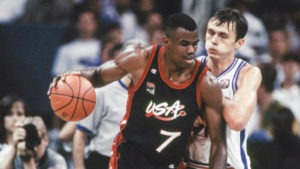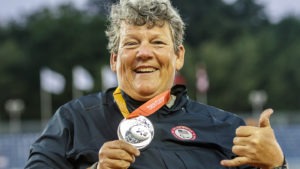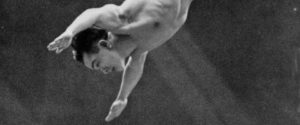
Andre Shelby was the first Black U.S. Paralympic archer, winning gold at Rio 2016
The first Black American archer to compete at the Paralympic Games, he was seeded 12th in the compound open tournament at Rio 2016 but captured the gold medal.

Many Olympians and Paralympians who have served in the military say there are strong similarities between the discipline required in the armed forces and the dedication and drive with which they attacked their athletic training. Explore this collection of stories about Olympic athletes who served in the military.
Learn more about their incredible stories during Military Appreciation Month at the U.S. Olympic & Paralympic Museum on the Military Appreciation Month Specialty Tour. Get Tickets Today!

The first Black American archer to compete at the Paralympic Games, he was seeded 12th in the compound open tournament at Rio 2016 but captured the gold medal.

Wounded while serving in Afghanistan, he took up cross-country skiing and five years later competed at Vancouver 2010.

Yosh Uchida coached the first U.S. Olympic Judo Team. More than half a century later, at 100 years old he remains the San Jose State University head judo coach.

When he arrived in Sweden for the first-ever Paralympic Winter Games in 1976, Bill Hovanic was a one-man American delegation.

Captain of the swim team at the U.S. Naval Academy, he rediscovered swimming after being injured while serving in Afghanistan.

After serving in the U.S. Army in World War I, Charley Paddock participated in three Olympic Games, winning two gold medals and two silver. He died in a plane crash while serving in World War II.

David Robinson did not stand out on the basketball court until starring at the Naval Academy. He played in three Olympic Games, winning two gold medals and one bronze.

Life in the Wigger household revolved around shooting; Lones Wigger is regarded as the top shooter in Team USA history.

Twelve years after winning a boxing gold medal, bobsledding rookie Eddie Eagan added another gold medal in his first and only bobsled race.

Harrison “Bones” Dillard is the only man to win Olympic gold medals in the 100-meter dash and the 110-meter hurdles. In between the 1948 and 1952 Olympic Games, he served in the U.S. Army.

Snubbed by the elite Diamond Sculls, Jack Kelly Sr. entered the Antwerp 1920 Olympic Games just to gain a measure of revenge. He did just that, claiming gold medals in the single and double scull.

One of the most dominant athletes of his generation, John Davis compiled a 15-year winning streak that included gold medals at the London 1948 Olympic Games and the Helsinki 1952 Olympic Games.

The trio of team handball athletes took unconventional routes to becoming Olympians.

Labeled the “greatest shooter in history,” Lones Wigger Jr. won two gold medals and one silver over the course of three Olympic Games before becoming a director at the U.S. Olympic Training Center.

After competing at Berlin 1936, it was thought the distance runner’s best years were ahead of him; instead he served in the U.S. Army Air Corps

Mal Whitfield won gold in the 800-meter run and the 4x-400-meter relay at the London 1948 Olympic Games, becoming the first American active-duty service member to win an Olympic gold medal.

Winning bronze felt like gold to Melissa Stockwell (right) at Rio 2016.

Micki King hit her arm on the board on her ninth dive of the 3-meter springboard at the Mexico City 1968 Olympic Games and finished fourth. She won gold at the Munich 1972 Olympic Games.

Discover some of the most successful former U.S. service members who found success as Olympic & Paralympic athletes for Team USA.

Three-time Paralympic handcyclist Oz Sanchez, who has gold medals among his six Paralympic medals, is proud of his Mexican heritage.

Three-time Paralympian Angela Madsen won the bronze medal in shotput at London 2012.

A second lieutenant in the U.S. Army Reserve, pole vaulter Sam Kendrick stopped in the middle of his approach when he heard the Star Spangled Banner.

Diver Sammy Lee overcame racial prejudice while growing up to become the first Asian-American man to win an Olympic gold medal.

It was at an internment camp in the desert during World War II that Tommy Kono’s asthma dissipated and he was introduced to weightlifting, eventually winning two Olympic gold medals and one silver.

A member of the U.S. Army Marksmanship Unit at Fort Benning, Hancock was perfect on 25 shots in the final in men’s skeet shooting at London 2012.

The determination and dedication these athletes displayed in athletics helped them become leaders in the military as well.

Willie Davenport ran the 100-meter hurdles in four Summer Games and won one gold medal. At the Lake Placid 1980 Olympic Winter Games, he was part of the U.S. four-man bobsled team.